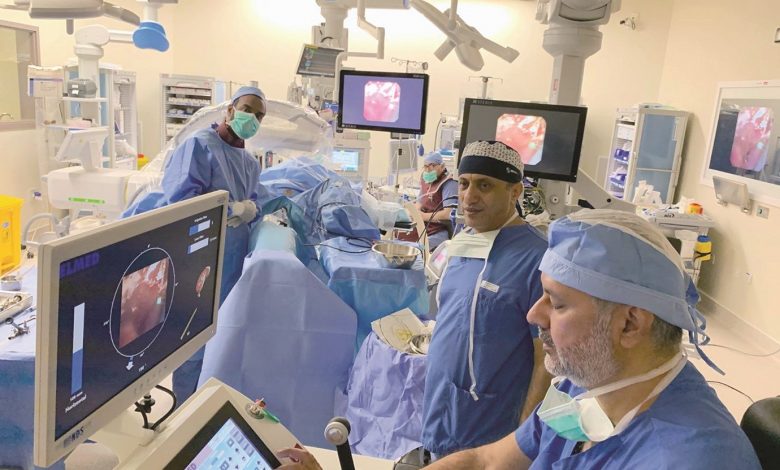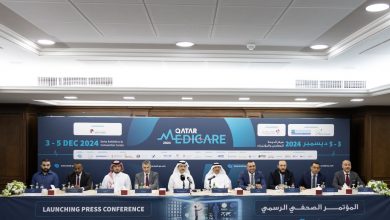
First robotic procedure to treat kidney stones
لأول مرة جراحة ناجحة لتفتيت حصوة كلوية بمنظار الروبوت
A team of surgeons at Hamad Medical Corporation (HMC) has performed the first kidney stone treatment procedure using the Roboflex surgical robot at Hazm Mebaireek General Hospital (HMGH).
The state-of-the-art flexible laparoscope technology allows for the effective, non-invasive treatment of kidney stones and the operation marked the first time the Roboflex technology has been used at Hazm Mebaireek General Hospital, which is located in the Industrial Area of Doha.
Dr Abdulla Al Ansari, Acting Chief Medical Officer at HMC and Senior Consultant and Chair of Surgical Services, along with Dr Morshed Ali Salah, Senior Consultant, Surgery and Head of the Surgery and Urology Departments at Hazm Mebaireek General Hospital have performed the procedure.
“The successful completion of this procedure marks the first time we have used this technique at Hazm Mebaireek General Hospital. This technology was developed by clinicians from Turkey and breaks up kidney stones using a laser. The procedure can be performed under general anaesthesia and doesn’t require a surgical incision, which typically means the surgery is performed in less time and with the patient having a shorter recovery period and experiencing less pain. We expect to conduct around two hundred surgeries each year at Hazm Mebaireek General Hospital using this technology,” said Dr Al Ansari.
Dr Moustafa Al Khalil, Acting Medical Director, Hazm Mebaireek General Hospital, said the success of the first surgery using the new technology is an important milestone.
“The introduction of the Roboflex surgical robot at Hazm Mebaireek General Hospital is evidence of our commitment to improving patient care by offering the highest standard of therapeutic treatment. We are pleased to be able to provide our patients with the latest technology and efficient medical expertise,” said Dr Al Khalil.
Dr Salah said the patient, a man in his forties who had a large stone measuring approximately two centimetres in the right kidney, was an ideal candidate for the procedure due to the size and location of his stone.
“The most common form of kidney stone removal is the laparoscopic technique. In this technique, a laparoscope is passed through a small incision in the waist area and then used to break the stone, or stones, into smaller pieces, which can then be removed using special surgical tools. In the case of this patient, a more advanced treatment was required due to the size and position of the stone. This advanced technique involves passing a laparoscope through the urinary tract before using a laser to break the stone into smaller pieces. We are pleased to now be able to offer this treatment to patients here at Hazm Mebaireek General Hospital,” said Dr Salah.
Kidney stones are hard collections of salt and minerals often made up of calcium or uric acid. They form inside the kidney and can travel to other parts of the urinary tract. Stones vary in size and can remain inside the body for weeks with many patients experiencing a range of side effects, including painful and frequent urination, severe lower back and abdominal pain, nausea, and fever.
While some kidney stones pass on their own, others require medical treatment. To help reduce the formation of kidney stones, doctors recommend drinking up to three litres of water a day, which promotes urine output and helps flush out the urinary system.
أُجريت مؤخراً بنجاح في مستشفى حزم مبيريك العام التابع لمؤسسة حمد الطبية، أول جراحة لتفتيت حصوة كلوية باستخدام المنظار المرن بمساعدة الروبوت الجراحي، حيث تم استخدام جهاز «روبوت ابن سينا Roboflex» المتطوّر لأول مرة في هذه العملية.
أجرى الجراحة الدكتور عبدالله الأنصاري استشاري أول ورئيس أقسام الجراحة بمؤسسة حمد الطبية، والدكتور مرشد علي صلاح استشاري أول ورئيس أقسام الجراحة ورئيس قسم المسالك البولية بمستشفى حزم مبيريك.
وفي تعليق له على نجاح العملية، أكد الدكتور عبدالله الأنصاري أن إجراء جراحة متطوّرة من هذا النوع عقب افتتاح مستشفى حزم مبريك العام بشهور قليلة، يؤكد جاهزية مؤسسة حمد الطبية لتطوير الأداء الجراحي في المستشفيات كافة التابعة لها وفقاً لأفضل المعايير الدولية.
وقال الدكتور الأنصاري: «استخدمنا للمرة الأولى جهاز روبوت متطوّراً قام بتطويره أطباء من تركيا، حيث يُستخدم لتفتيت الحصى بأشعة الليزر عن بُعد تحت التخدير العام، عبر مجرى البول، دون الحاجة إلى إجراء أي فتحة جراحية. كما يقلّل الوقت المحدد للعملية ويسرع في تعافي المريض بعد إتمام الجراحة». وأشار الدكتور عبدالله الأنصاري إلى أنه من المتوقع إجراء أكثر من 200 عملية من هذا النوع سنوياً باستخدام جهاز روبوت ابن سينا في مستشفى حزم مبيريك العام.
وقال الدكتور مصطفى الخليل المدير الطبي لمستشفى حزم مبيريك العام: «يؤكد نجاح أول جراحة لتفتيت حصوة بالكلى باستخدام جهاز «Roboflex» المتطوّر، على المستوى الجراحي المتميّز الذي يوفّره مستشفى حزم مبيريك العام، والتزامنا بتحسين الرعاية المقدمة للمرضى، من خلال تطبيق أعلى معايير الرعاية العلاجية، حيث يضم المستشفى أحدث الأجهزة والمعدّات الجراحية، بالإضافة إلى الخبرات الطبية الكفؤة».
ومن جهته، أوضح الدكتور مرشد علي صلاح أن الجراحة الناجحة أُجريت لمريض في الأربعينيات من عمره يعاني من حصوة في كليته اليمنى بحجم سنتيمترين اثنين، وفي العادة تُزال هذه الحصوات بالمنظار الجراحي العادي بديلاً عن الشق الجراحي؛ ولكن استخدام المنظار المرن بمساعدة الروبوت الجراحي يُعدّ التقنية الأكثر تطوّراً في هذا النوع من الجراحات.



